Realizing that the fantasy genre can be pretty euro-centric, I decided to start researching mythologies of the world to potentially enrich the source materials and look for inspiration. Don’t forget to share on Twitter and Facebook, as this is definitely a message that doesn’t get out enough.
One of the most influential but lesser known cultures of the West African region was the religion of the Fon people of the Dahomey Kingdom in modern day Benin. Though the Fon people were followers of West African Vodou, the Dahomey variation of Vodou was unique for bringing in several pre-existing animist traditions that spread through the rest of West African Vodou and even into the Vodou practiced in the western world (especially South America).
Because of this, they share a similarity to the Amazigh in the way that other, better known, cultures are given credit for ideas that originated there. In fact, when looking through concepts that are better known for their representation in Vodou, you can find that several of them originated with the more animist inspired Fon traditions from the Dahomey Kingdom.
So, before eventually hitting Vodou down the line, it’s only fair to take a look at the major contributions made by…
Dahomey
Unlike their close neighbors, the Akan of the Ashanti Empire, the Fon people of Dahomey were a polytheistic culture with several gods and a heavier emphasis on their animist roots. While the Akan believed nature spirits were simply extensions of their supreme deity, Nyame, the Fon believed that the various aspects of nature were usually gods unto themselves and that their supreme deity wasn’t necessarily all powerful. In fact, most of the Dahomey contributions to Vodou were spirits which were vital to the world and yet not infallible at the same time.
These traditions spread through the neighboring cultures which practiced Vodou and through the Yoruba people (both of which we will be getting to later). The Fon later adopted Christianity and Islam like many of their neighbors, but the impact they left through their traditions have survived into the modern day and are still present through many areas of West Africa and even on the other side of the world in South America.
One of their first contributions to stand the test of time is the inclusion of their gods associated with…
Creation
Unlike many other cultures, the creator deities (plural) of the Dahomey religion are not all-powerful, all-knowing entities. Their supreme deity, Nana Buluku, is an androgynous an ancient entity which is said to appear to be older than the universe and was the first thing to come into existence. Despite the androgynous nature of her depiction, Nana Buluku’s role is often that of the mother and ruler of the universe. Her act of creation is often an indirect one, giving birth to the twin entities Mawu (sometimes Mahu) and Lisa (sometimes Lisu) – the moon and the sun.
Mawu, the goddess of the moon, and Lisa, the god of the sun, are often depicted as being twins who are two halves of the same whole known as Mawu-Lisa. After being born to Nana Buluku, Mawu-Lisa carried out the creation of the universe over the course of four days. In the first day, Mawu-Lisa created the universe and mankind, though not necessarily a universe which was friendly to the existence of mankind. In the second day, Mawu-Lisa made the Earth suitable for human life so that mankind would have a place to live. In the third day, humans were made intelligent and aware of their world, given the knowledge and ability to be able to live on the land they were given. On the fourth and final day, Mawu-Lisa granted to humans the ability to create tools they would need to be able to carry out the tasks they were given.
Interestingly, during their creation of the universe, Mawu-Lisa wasn’t perfect. There were still things to be done and tasks to be carried out after the initial creation. Unlike similar stories such as the seven days creation myth of Abrahamic Religion, when Mawu-Lisa looked out on what they had created they didn’t just declare it was good and then leave it at that. Rather, Mawu-Lisa gave birth to new deities which carried out tasks that still needed to be done. The most commonly referenced of these are Dan, Gun, and the So pantheon. Each of these were given different tasks and each of them are said to continue these tasks even to this day.
Dan
One of the most important of the deities born to Mawu-Lisa was Dan, the snake. Later adopted as “Damballa” in Vodou, Dan is often said to be the actual creator of all life in some variations of the story. However, as it was originally in the Dahomey traditions, Dan the snake is a world serpent very similar to stories found around the world, especially for traditions like the Naga of Hindu stories. Dan coils beneath the universe 3,500 times and another 3,500 times above the universe to support the heavens and the Earth. Essentially, when you look at the sky, you’re looking at the belly of Dan over your head. So, remember to say hi to Dan.

In Vodou, Dan as Damballa also came to be the protector of the unfortunate and the weak. He brings balance to the world and is seen as a giver of life and ruler of wisdom. In Vodou traditions, Damballa is seen as the originator of all other spirits as well and uses these spirits to keep the world in balance. Because of this, Dan as Damballa is known to many practitioners of Vodou today as “Papa Damballah” – the father of creation.
When Damballa communes with the mortal world he does so with the sounds of a snake and cannot be understood by humans. To commune with the people below he is said to possess people from time to time, hissing and whistling through the people he has touched. Meanwhile, in other branches of Vodou, they believe that the hissing and crackling noise of a fire is actually the voice of Dan reaching the mortal world through the flames.
This belief that Dan/Damballa is in constant contact with the mortal world extended even to the people who were later converted to Christianity. To those who hold both Vodou and Christian beliefs, all references to serpents in the bible are essentially extensions of the power of Dan. These manifestations can be things such as St. Patrick chasing the snakes from Ireland, Moses’ staff turning into a snake, or even to the likes of the serpent in the garden of Eden. While the Christian view is that knowledge was a corruption of man, Dahomey tradition views intelligence and the ability to care for yourself as virtues.
That virtue brings us to the next child of Mawu-Lisa…
Gun
Gun, brother of Dan, is another deity which spreads through Vodou and Yoruba traditions from the Dahomey. God of crafts, Gun has two jobs which he is tasked with for the most part. The first of these is to be the patron deity of smiths and craftsmen. When Mawu-Lisa granted the gift of technology to humanity, Gun was the one who would oversee this gift. Through Gun, humanity learns of tools, weapons and creation.
In this creative role, Gun is often represented as a supremely gifted craftsman who can create all things and will create the things that other gods may need. Through the creation of these objects he is also the god of hunting and, by relation, the god of war as he inspires the creation of the weapons used to wage it. Because of these attributes, not only is Gun a god of creation but a god of all things which may lead to conflict such as politics, war, and philosophical concepts such as truth.
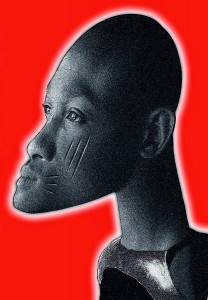
But the other task to him, arguably a more important task, was to use those tools he created to go about making the world comfortable for human life. As Mawu-Lisa made the Earth livable for humanity on the second day, Gun was tasked with continuing the job to completion. However, according to all traditions which worship Gun… he still hasn’t finished this task.
This once again leads back to the idea that the gods of Dahomey were not all-powerful entities but rather just vital players in the creation of the world. Despite his divine origins, Gun simply can’t make the world perfect overnight, and because of this there are other gods who act on humanity’s behalf in the meantime. These gods are the…
So Pantheon
The So Pantheon are regional thunder gods which act as the patron deities of specific areas within the Dahomey Kingdom. Each of these “So” were given a region within the kingdom which they watched over and their names often designated where they were. For instance, Xevioso, one of the more common names associated with one of the gods and sometimes the entire pantheon, was the thunder god of Xevie. Xevioso’s name often extends to the whole pantheon due to the fact that Xevie was a village in the southern territories of Dahomey which housed most of the shrines devoted to the So.
However, while Xevioso’s name often extends to the other So or the Pantheon itself, he is not the chief of the group. Leading the So Pantheon is Sogbo, the Dahomey god of thunder, lightning and fire often represented as a red colored ram in the sky. Sogbo leads the pantheon as guardians of their followers, protecting them in the still imperfect world (get on it, Gun). In response, the human worshippers of the So Pantheon also refer to themselves as Sogbo, identifying themselves with the chief god.
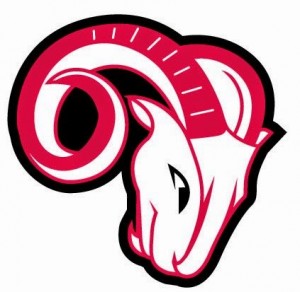
Among some of the people who believe in Sogbo, several identify him as being an aspect of Mawu-Lisa and thus a creator deity. For those who do believe this, there are those who believe that Sogbo aligns with one half (often Mawu), while Agbe, god of the sky, is identified with the other half. Often, when this relationship is invoked, Sogbo is the mother goddess, thus being also associated with Nana Buluku, while Agbe becomes the governing deity and child of Sogbo, thus Mawu-Lisa or simply Lisa.
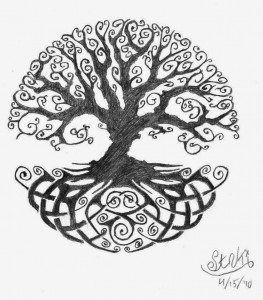
But among the cultures influenced by Dahomey traditions, it is not uncommon for certain concepts, deitites and names to be interchanged over time. It’s because of this that one of the other most prevalent influences left on other cultures by the Dahomey is one that features traits of Nana Buluku, Dan, and animist spirits at the same time. This entity is known as…
Mami Wata
Originating with the Dahomey but getting her name from more modern Vodou practices, Mami Wata is a water spirit known throughout Africa and the Americas due to her spread from culture to culture. Her connection to the various spirits and deities mentioned so far are many and she is a true example of a myth being an amalgamation of all the cultures which touch it.
To the Yoruba, Mami Wata is connected to Nana Buluku while to the Benin she is Mawu-Lisa in another form. Meanwhile, in places such as Trinidad, she is a nature spirit, guardian of plants and animals, protecting them from overzealous humans degrading the quality of nature. Essentially, Mami Wata is one of the most versatile entities of West Africa, being whatever she needs to be. The things that remain in all depictions is that she is a water spirit with a deep connection to nature, healing, fertility and prophecy.
She appears to people in many forms, often dependent on her goal as she arrives. To some she appears as a woman with long dark hair of varying styles, wandering market places or bars. To others she appears as the same woman carrying a great snake which coils about her, a symbol of her divinity to let those who see her know her true nature. But in times when she wishes to truly show her divinity she may even be half snake herself, once again showing a deep similarity between the Dahomey and Hindu despite being on two different continents.
When she appears to people, her goals are often beneficial. She is known to abduct her followers, taking them into the waters and transporting them to her realm. Should she let them return to the mortal world they will emerge from the water dry and with a new understanding of the world. For others who encounter her on land, they can chance upon her as she grooms herself, fleeing once she notices the person who sees her and leaving her possessions behind. If the person gathers these things, she will return to them for it and exchange these things for favors. In both instances, the person who encounters her leaves the encounter with wealth – either spiritual or material.
Mami Wata is a beneficial entity: a protective, healing force of the world which keeps man and nature healthy. She acts as a motherly figure, whose association with snakes is a positive attribute due to her origins. The snake, whether it be Mami Wata, Mawu-Lisa or Damballa is a positive force. Which is why Damballa and those associated with him inspire creative acts such as this…
While Gun gets associated with accidents.
(I write books. I’m happy to have updated my blog twice this week, which makes me slightly more effective than Gun. Get it done, Gun.)


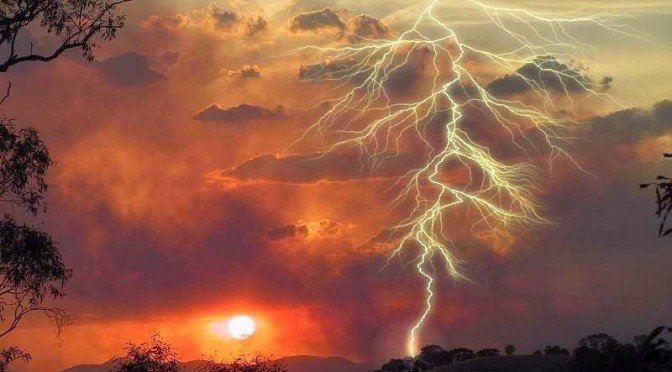

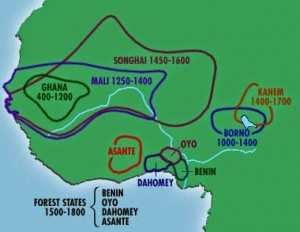
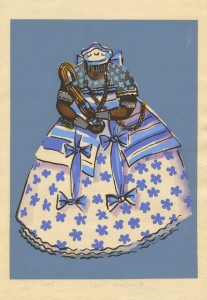

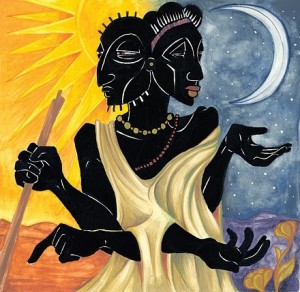
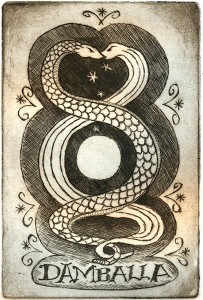


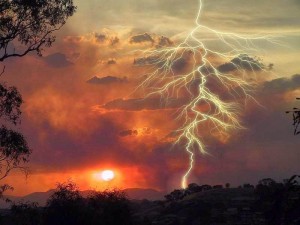
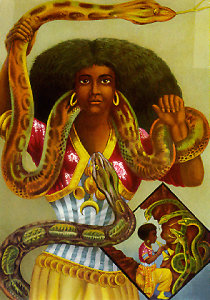
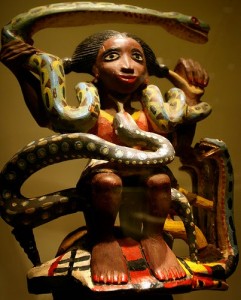
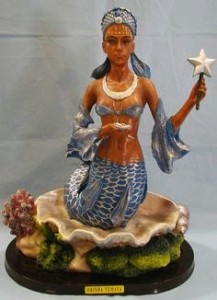





Thank you so much for this. I am trying to satisfy a longing in my spirit to connect with the spirituality of my “originals”. I can not seem to find peace in the modern religions of today so I am trying to find my way backwards.
This has been a great start! Do you have anything else on the religions of the people of Dahomey and Benin?
Not for a while more, I’m afraid. The Alternative Mythologies series is going to take one full trip around the world before I come back to do more pieces on each region. Now that I’ve gone through multiple cultures in Africa I’ll be focusing on the Americas for a while, but once I’m through there I look forward to being able to take more looks into cultures I’ve visited before. I’d love to do them a little faster, but they require more research than other posts on the site and I wouldn’t want to post misinformation.
Thanks for reading though and I’m glad you appreciated it. I hope to have more on the cultures around Benin in the future.